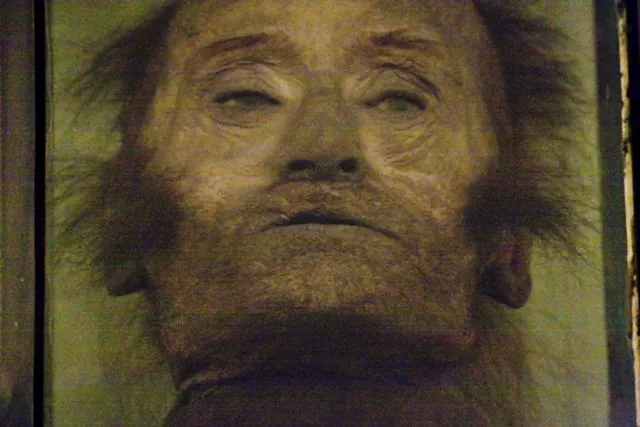A Blue-Eyed Mummy in the Gobi Desert: What Ancient Rituals Lay Buried with Him?
In 2006, deep in the Xinjiang desert in northwest China, a group of archaeologists made a discovery as puzzling as it was fascinating. While excavating an ancient necropolis known as the Yanghai Tombs, near the city of Turpan, they came across an extraordinarily well-preserved Iron Age mummy. Initially seemingly just another archaeological find in the region, this discovery soon revealed secrets that challenged conventional accounts of the ancient cultures of Central Asia.

The mummified body, identified as that of a man around 45 years old, rested in Tomb 90 of the archaeological site. What most caught the scientists’ attention was his appearance: he had marked Caucasian features, prominent cheekbones, an elongated nose, and—to everyone’s surprise—his blue eyes were still visible thanks to the dry, saline desert environment, which allowed for exceptional natural preservation.
The big question was inevitable: what was a man with European features doing buried in the heart of Asia thousands of years before the Silk Road connected East and West?
As the investigation progressed, experts came to a fascinating conclusion. The mummified man likely belonged to the Gushi , an ancient nomadic people who inhabited the Tarim region during the first millennium BC. The Gushi spoke an Indo-European language called Tocharian , distantly related to languages such as Latin, Celtic, and Greek. This suggests that migratory and cultural contacts existed between the Eurasian steppes and inner Asia more than 3,000 years ago.
The Gushi were not simple nomads. Archaeological evidence suggests they were expert horsemen, organized herders, skilled archers, and refined musicians. Their lives revolved around survival in the harsh conditions of the desert and a rich and complex cultural life.
What truly elevated the discovery’s significance wasn’t just the mummy itself, but the artifacts buried alongside it. Among the items found was a wooden bowl carefully protected inside a leather basket… containing a stash of still-green marijuana .
This discovery was particularly striking. The cannabis wasn’t there by chance. Its deliberate preservation suggests ritual or medicinal use. Laboratory analysis showed that the plants contained high levels of THC, the psychoactive component of marijuana, indicating that it wasn’t just textile hemp, but a variety cultivated for specific purposes.
The picture that emerges from the analysis of Tomb 90 and many others in the Yanghai complex contradicts the traditional view that inland Chinese cultures were isolated or primitive in ancient times. On the contrary, the Gushi demonstrated a rich worldview, advanced spiritual practices, and a remarkable knowledge of the properties of plants and materials.
The ritual use of cannabis suggests shamanic practices similar to those of other indigenous cultures around the world, such as the Siberian peoples, the Celts, and the ancient Scythians. The musical instrument indicates the presence of ceremonies or rituals where music played a central role.

Furthermore, the fact that they were buried with such care and with objects of symbolic value demonstrates that they had a profound respect for death and spiritual transcendence.
The Yanghai Tombs have revealed more than 500 similar burials, many with equally well-preserved bodies and accompanied by an array of unique artifacts. However, Tomb 90 stands out for its symbolic richness and the impact it has had on understanding human migrations and cultural diversity in Asian prehistory.
For centuries, the Gushi were a forgotten civilization. Not even Chinese chronicles mentioned them clearly. But the desert wind, in its eternal movement, stirred the sand that covered their history. And now, thanks to modern science, we know that in the Tarim dunes lived a people who spoke languages related to those of Europe, who cultivated their spirituality with music and sacred plants, and who left a legacy that we are only just beginning to understand.








